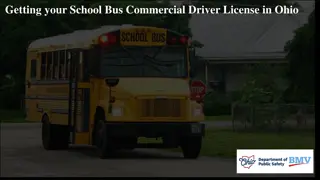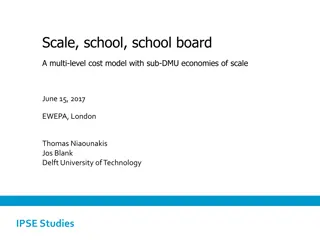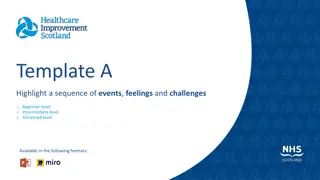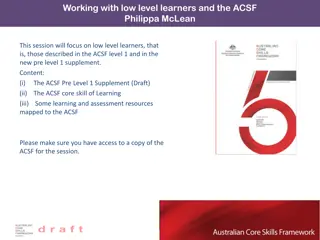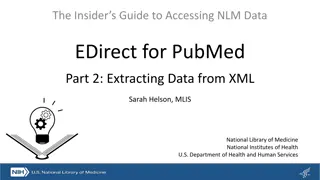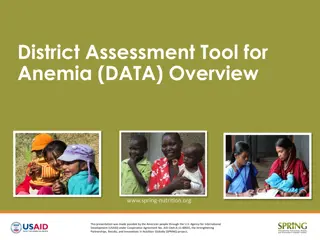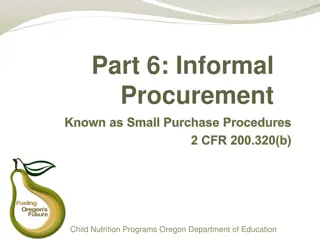Strategies for Obtaining and Utilizing School-Level Data Effectively
Explore effective strategies for obtaining and utilizing school-level data, including options such as leveraging existing data, requesting electronic files, and issuing surveys. Examples from Colorado and Wisconsin showcase the importance of data standards and analyses in education decision-making. Discover how to determine what level of data accuracy is "good enough," and learn about the significance of real salaries, financial information, and personnel data in making informed education policies.
Download Presentation

Please find below an Image/Link to download the presentation.
The content on the website is provided AS IS for your information and personal use only. It may not be sold, licensed, or shared on other websites without obtaining consent from the author. Download presentation by click this link. If you encounter any issues during the download, it is possible that the publisher has removed the file from their server.
E N D
Presentation Transcript
By: Marguerite Roza Edunomics Lab at Georgetown University
Communicating During the Call To request to be unmuted, please use the hand raise tool Use the comment box to ask questions or message the group bscpcenter.org 2
Agenda 1. Need. Data. Now. 2. How good is good enough? 3. Examples Colorado 4. Developing a framework for data standards Wisconsin bscpcenter.org 3
Need. Data. Now. 3. SEA has real salaries/benefits of personnel with location 2. SEA has SLFS (or similar) data by school 4. SEA does not yet have access to financial information by school: 1. SEA has a chart of accounts (COA) with a field for location CO DE, FL, HI, MA, ME, MS, OH, RI, DC, MD, WY, OR, NE, MD CT. IL ND, VA, AZ, SD, MO, TN 1. 1. Already have data (lucky you). data, or SLFS data). Next steps: run early analyses of the data and consider allocation rules for centrally assigned costs. Already have data (lucky you). Your SEA already has data (be it expenditure data, salary 2. 2. Ask for electronic files. consistently) and you could ask for the raw data files and do any work of integrating & calculating the PPE from those files. Files to collect might include expenditure data and/or personnel files. Ask for electronic files. Maybe Maybe LEAs in your state are using location codes (even if not 3. 3. Issue a survey. inconsistent as to warrant SEA analysis. A third option is to issue a SURVEY to collect information from your districts. One tested survey instrument is the SLFS survey, but you could issue your own. Issue a survey. Perhaps electronic files won t yield anything of value or are so
How will your state obtain school level data? Use chat box to indicate which option # applies to your state: How will your state obtain school level data? Use chat box to indicate which option # applies to your state: 1. 1. Already have data (lucky you). expenditure data, salary data, or SLFS data). Next steps: run early analyses of the data and consider allocation rules for centrally assigned costs. Already have data (lucky you). Your SEA already has data (be it 2. 2. Ask for electronic files. (even if not consistently) and you could ask for the raw data files and do any work of integrating & calculating the PPE from those files. Files to collect might include expenditure data and/or personnel files. Ask for electronic files. Maybe Maybe LEAs in your state are using location codes 3. 3. Issue a survey. are so inconsistent as to warrant SEA analysis. A third option is to issue a SURVEY to collect information from your districts. One tested survey instrument is the SLFS survey, but you could issue your own. Issue a survey. Perhaps electronic files won t yield anything of value or 4. Not sure yet.
How good is good enough? Already have electronic data Collect data files Issue a survey Rhode Island: has common COA, rules about what is/is not coded to schools & how, collects at the state level MD AIR Study: collected electronic data files from districts (expenditure survey & personnel) to find PPE at school-level SLFS: federal survey issued to districts that collects school- level data on a subset of expenditure categories Examples What portion is tracked to the school-level? 65-98% ~54% 37-54% Minimal burden to LEAs. SEAs can do all the analysis. LEA must extract and send files. Time and resources at SEA level to clean, merge, analyze LEAs to complete survey, and SEAs to review & verify What s the burden?
Additional considerations Already have electronic data Collect data files Issue a survey Depends Higher if common COA, lower if not Depends on whether there are some common practices re attribution or COA specifies attribution High SEA controls framework for analysis Uniformity? Medium-High: variation in LEA interpretation & reporting Lower: LEA coding errors might exist, although patterns should be evident in the data. Medium-Low: LEA coding errors, but can be checked at SEA level Chance for error? Survey must include breakout by source of expenditures (SLFS has with and without exclusions) Run consistency checks across districts to explore uniformity in attribution May be a good short term strategy -- gives SEA opportunity to standardize Other considerations For all, worth triangulating w/ add l data sources (i.e. personnel files; F-33s) bscpcenter.org 8
How good is good enough? Attributing costs by formula Average error across sites studies (Percentage difference between tracked and formula allocated) 0% 10% 20% 30% 40% 50% 60% Health benefits attributed by: Staff FTE Counts If attributing health or retirement benefits by formula, better to do so by STAFF SALARY. Staff salary Retirement benefits attributed by: Staff FTE Counts Staff salary Error (Percentage difference between tracked and formula allocated) Pupil support costs attributed by: Pupil support and instructional support not well attributed by these formulas Staff FTE Counts Enrollment Instructional support costs Staff FTE Counts Enrollment Source: U.S. Department of Education, Office of Planning, Evaluation and Policy Development, Policy and Program Studies Service, Exploring the Quality of School-Level Expenditure Data: Practices and Lessons Learned in Nine Sites, Washington, D.C., 2017. bscpcenter.org 9
How good is good enough? Attributing costs by formula Considerations on how/whether to attribute costs (vs leaving costs at LEA level) -- Amount of money involved -- Relevance for schooling -- How much error if done formulaically vs via actual costs -- Lumpiness of spending -- Frequency of costs incurred (yearly, once per decade, etc.). ERS is working on a tool for LEAs to explore attribution of central costs. Let us know (via chat box) if you d like to be part of a webinar demonstration bscpcenter.org 10
Analysis of one CO school district SLFS Expenditure Files (w/o exclusions) Elementary School Middle School High School Elementary School Middle School High School A School level Federal $675 $209 $197 N/A N/A N/A B S/L $6,378 $6,856 $8,463 N/A N/A N/A C Sch total $7,052 $7,065 $8,659 $7,891 $6,838 $8,955 D LEA level Federal $61 $61 $61 N/A N/A N/A E S/L $2,378 $2,378 $2,378 N/A N/A N/A F LEA total $2,439 $2,439 $2,439 $2,586 $2,586 $2,586 G Grand Total $9,492 $9,504 $11,099 $10,477 $9,424 $11,541 Expenditure file captured 78% of selected expenditures at the school level. SLFS data (without exclusions) captured 76% of total expenditures (F-33) SLFS data with exclusions captured 65% of total expenditures (F-33) Exclusions include: 1) expenditures from federal revenue sources other than federal funds intended to replace local tax revenues, 2) prekindergarten expenditures, and 3) special education expenditures bscpcenter.org 11
Possible Framework for Drafting Reporting Standards: The goal: Enable spending comparisons across schools in different states. Tier 1: Minimum Tier 2: More information Tier 3: Richest data Define student enrollment count procedures Clarify what expenditures are excluded/included or how to specify All LEA expenditures accounted for (in either school level or LEA level Specify minimum breakouts: Special ed, bilingual ed, nutrition, transportation, etc. Specify additional breakouts re objects, functions, etc. (benefits, etc.) Clarify options for attribution Align with comparable student outcomes (percentiles?) bscpcenter.org 12
Milwaukee example bscpcenter.org bscpcenter.org 13 13
Resources MD AIR Study: http://www.marylandpublicschools.org/about /Documents/OCP/Publications/MarylandStud yPublcSchoolFunding122016.pdf DoE AIR Study (Case study on 9 sites, including RI and HI) https://www2.ed.gov/rschstat/eval/title- i/quality-expenditure-data/report.pdf bscpcenter.org 14










